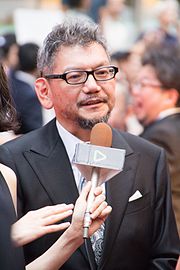User:TeenAngels1234/Sandbox3
Production
[edit]Genesis and staff
[edit]
From 1993, Gainax wrote a presentation document for Neon Genesis Evangelion entitled New Century Evangelion (tentative name) Proposal (新世紀エヴァンゲリオン (仮) 企画書, Shinseiki Evangelion (kari) kikakusho), containing the initial synopses of the planned episodes.[1][2] The Proposal was published in 1994.[3][4] For the first twelve episodes aired, the company followed the proposal's schedule with only a few minor script differences.[5][6] From the thirteenth episode onward, the production deviated from the writers' original plan and from the submission document.[7] According to Michael House, American translator for Gainax,[8] Neon Genesis Evangelion's main director Hideaki Anno initially intended to give the story a happy ending but during production, he realized he had created problematic characters so he changed his plans.[7] Furthermore, according to Hiroki Azuma, a culture critic who interviewed Anno, during the airing of the series, Anno began to criticize obsessive anime fans, known as otaku,[9][10] whom he considered closed-minded and introverted,[11] and changed his original plans by creating a more-dramatic, introspective mid-series story.[12]
Shinji Higuchi[13][12] and Hideaki Anno wrote the screenplay for "Ambivalence",[14][15] while Tensai Okamura produced the storyboards.[16] Okamura also directed the episode, assisted by Masahiko Otsuka and Ken Ando[17] and with Kazuchika Kise as chief animator.[18][19] Production also involved studios other than Gainax, including Studio Mark[20][21] and Production I.G. Production I.G previously worked on the animation for the thirteenth episode,[22][23] which already presented an invisibile microscopic Angel, Iruel.[17][24]
Development and writing
[edit]
Gainax decided the basic plot for the eighteenth episode in the 1993 Proposal, with Shinji fighting an Angel-controlled Eva-03 piloted by his friend and making a choice.[25] Hiroki Azuma noted that while Evangelion parodied previous animes and used "a lot of clichés", especially in the first part, Anno later subverted the anime tropes. While comic characters like Asuka and Toji "must not be seriously injured in an anime", Anno broke the implicit expectations with the public making them injured in battle.[10] Shinji Higuchi, who worked on the episode's script,[26] had previously written the storyboards[27] for "Asuka Strikes!"[28][29] and "Both of You, Dance Like You Want to Win!".[30][31] He also wrote the previous episode, "Fourth Child", as an anticipation of "Ambivalence".[32] According to writer Virginie Nebbia, Higuchi borrowed this scheme of two linked episodes from the Ultraman franchise.[33] Because of his commitments to Gamera 2: Attack of Legion (1996), after writing the draft for "Fourth Children" and Ambivalence" he left the rest to Anno, causing problems for the production.[34]
- ^ Nebbia (2023), Cap. 1: Lancement du Project Eva
- ^ Evangelion Chronicle (in Japanese). Vol. 1. Sony Magazines. p. 26.
- ^ Nebbia (2023), Chap 2: La Proposition
- ^ "History 1993-1999". Neon Genesis Evangelion Blue Ray Ultimate Edition Encyclopedia. 2021.
- ^ Gainax (1998). Neon Genesis Evangelion Newtype 100% Collection (in Japanese). Kadokawa Shoten. p. 88. ISBN 4-04-852700-2.
- ^ Neon Genesis Evangelion Theatralical VHS Box Booklet (in Japanese). King Amusement Creative. 1997.
- ^ a b House, Michael (November 28, 2011). "Interviewing translator Michael House". Archived from the original on August 24, 2020. Retrieved July 23, 2020.
- ^ Tomo no Kai, ミニミニゲリオンナ人達: Michael Houseの巻
- ^ Azuma, Hiroki. "Animé or Something Like it: Neon Genesis Evangelion". NTT InterCommunication Center. Archived from the original on August 8, 2012. Retrieved August 13, 2012.
- ^ a b Krystian Woznicki (September 1991). "Towards a cartography of Japanese anime – Anno Hideaki's Evangelion Interview with Azuma Hiroki". Blimp Filmmagazine. Tokuma Shoten.
- ^ "Kazuya Tsurumaki Interview". The End of Evangelion Theatrical Pamphlet (in Japanese). Gainax. 1997.
- ^ a b Nebbia (2023), Chap 1: Diffusion à la télevision
- ^ Nebbia (2023), Chap. 1: Production et catastrophes
- ^ Gainax (1998). Neon Genesis Evangelion Newtype 100% Collection (in Japanese). Kadokawa Shoten. p. 178. ISBN 4-04-852700-2.
- ^ 新世紀エヴァンゲリオン 原画集 Groundwork of Evangelion (PDF) (in Japanese). Vol. 2. Ground Works. 2020. p. 251. ISBN 978-4903713014. Archived from the original (PDF) on 26 October 2023.
- ^ Porori 2010, p. 52.
- ^ a b Poggio 2008, p. 62.
- ^ Evangelion Chronicle (in Japanese). Vol. 27. Sony Magazines. p. 25.
- ^ Evangelion Chronicle (in Japanese). Vol. 47. Sony Magazines. p. 1.
- ^ "Staff". Neon Genesis Evangelion Blue Ray Ultimate Edition Encyclopedia. 2021.
- ^ Gainax, ed. (2003). Data of Evangelion (in Japanese). Gainax. p. 23.
- ^ Poggio 2008, p. 48.
- ^ Oguro, Yūichirō. "第46回 エヴァ雑記「第拾参話 使徒、侵入」". Style.fm (in Japanese). Archived from the original on November 9, 2021. Retrieved July 23, 2020.
- ^ Platinum Booklet. Vol. 3. ADV.
- ^ Evangelion Chronicle (in Japanese). Vol. 19. Sony Magazines. p. 25.
- ^ Poggio 2008, p. 61.
- ^ Oguro, Yūichirō. "第41回 エヴァ雑記「第八話 アスカ、来日」". Style.fm (in Japanese). Archived from the original on October 10, 2018. Retrieved July 23, 2020.
- ^ Poggio 2008, p. 23.
- ^ Platinum Booklet. Vol. 2. ADV.
- ^ Poggio 2008, p. 32.
- ^ Oguro, Yūichirō. "第42回 エヴァ雑記「第九話 瞬間、心、重ねて」". Style.fm (in Japanese). Archived from the original on December 20, 2019. Retrieved July 23, 2020.
- ^ Platinum Booklet. Vol. 4. ADV.
- ^ Nebbia (2023), Chap 1: Tenir bon jusqu'à la fin
- ^ Tomo no Kai, ゲリオンな人達: 樋口 真嗣の達
